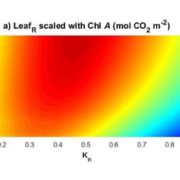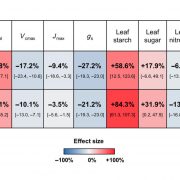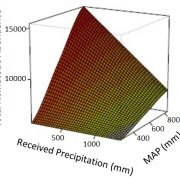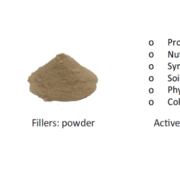A multi-species synthesis of physiological mechanisms in drought-induced tree mortality
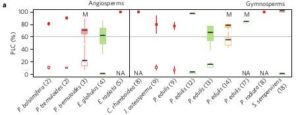 Global change forecasts include projections of severe droughts that could affect many forested biomes, largely influencing future energy and element fluxes. There are two physiological mechanisms associated with tree mortality in response to drought: hydraulic failure (inhibition of water transport) and carbon starvation (imbalance between carbon demand and supply). Adams et al. studied the prevalence or co-occurrence of these mechanisms at a global scale in drought-induced tree mortality by using a standardized physiological framework across species and assessing data from recent studies of percentage loss of xylem conductivity (PLC) and in-tissue non-structural carbohydrates (NSC). Their results show that tree mortality is universally associated with loss of hydraulic function (increased PLC) and is sometimes related to reduced NSC. Determining whether the co-occurrence of increased PLC and reduced NSC are facilitating death or a result of the mortality process requires more empirical work. Furthermore, knowledge of the physiological mechanisms underlying the mortality process, and the intensity and duration of drought needed to start tree death, is scarce and needed. Altogether, a better framework for developing mechanistic models is needed to more accurately predict future global carbon budgets. (Summary by Gaby Auge) Nature Ecol. Evol. 10.1038/s41559-017-0248-x
Global change forecasts include projections of severe droughts that could affect many forested biomes, largely influencing future energy and element fluxes. There are two physiological mechanisms associated with tree mortality in response to drought: hydraulic failure (inhibition of water transport) and carbon starvation (imbalance between carbon demand and supply). Adams et al. studied the prevalence or co-occurrence of these mechanisms at a global scale in drought-induced tree mortality by using a standardized physiological framework across species and assessing data from recent studies of percentage loss of xylem conductivity (PLC) and in-tissue non-structural carbohydrates (NSC). Their results show that tree mortality is universally associated with loss of hydraulic function (increased PLC) and is sometimes related to reduced NSC. Determining whether the co-occurrence of increased PLC and reduced NSC are facilitating death or a result of the mortality process requires more empirical work. Furthermore, knowledge of the physiological mechanisms underlying the mortality process, and the intensity and duration of drought needed to start tree death, is scarce and needed. Altogether, a better framework for developing mechanistic models is needed to more accurately predict future global carbon budgets. (Summary by Gaby Auge) Nature Ecol. Evol. 10.1038/s41559-017-0248-x


